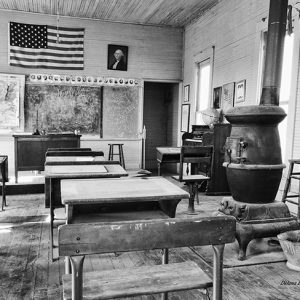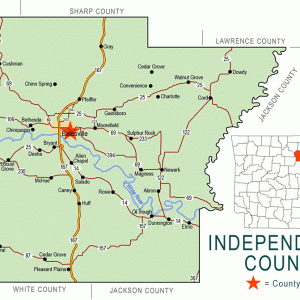calsfoundation@cals.org
Hulsey Bend (Independence County)
Historic Hulsey Bend was a farming community located in a bend of the White River in the Oil Trough Bottoms. Hardin Hulsey began farming there with his parents, Charles and Sarah Hulsey, in about 1815. Hulsey is considered a pioneer of Oil Trough (Independence County), which was originally called Pleasant Island. Hulsey Bend is located near where Highway 122 crosses the bridge from Newark (Independence County), four miles north-northwest, and merges with Highway 14 from Oil Trough, three miles west-southwest. Freeze Bend Country Road leaves Highway 14 going north toward the river and leads to Hulsey Bend, less than a mile away. Surrounding Hulsey Bend is alluvial farmland on which cash crops are grown—at one time, cotton, but today mainly soybeans. The White River has seen many floods over the years, at times devastating.
Hardin Hulsey was born on November 5, 1794, in Pendleton, South Carolina. He served under Andrew Jackson in the War of 1812. Following the war, Hulsey received a war bounty land grand of 143 acres of land in the White River bottoms. Hulsey married Nancy Smalley on January 1, 1824, in Independence County. Their family eventually consisted of nine children, seven girls and two boys, and they established a cotton plantation on the banks of the White River at what became known as Hulsey Bend. Hulsey increased his acreage from time to time, including the purchase of land on Pleasant Island.
Hulsey was a Democrat, and a meeting was called at his home in Hulsey Bend on May 23, 1840, to oppose the candidacy of William Henry Harrison on the Whig Party ticket. At the meeting, a resolution was adopted expressing this opposition and included this statement, arguing that Harrison was unqualified to be president: “[He ] does live in a buckeye log cabin and drinks his hard cider.”
The Civil War laid waste to Hulsey Bend as Union armies out of Batesville (Independence County) scoured the bottoms for Rebels, both regular and irregular. Most of the able-bodied men went off to war. Both of Hulsey’s sons, Marion and Joseph, joined the Confederate army, enlisting in Jacksonport (Jackson County) in 1861. Marion Hulsey participated in the Battle of Shiloh.
The farming community of Hulsey Bend slowly bounded back in the decades following the war, relying on sharecropping and tenant farming to replace slave labor. Hardin Hulsey died on April 2, 1867, at the age of seventy-two. His widow lived until 1876 and died in Carrollton (Carroll County) at the home of their daughter Eleanor. Their son Marion married Margaret Delia Neill, daughter of Judge Henry Neill of the prominent Neill family of Desha (Independence County). Elizabeth Hulsey, their oldest daughter, married James Fannin Saffold, a prominent member of the Arkansas General Assembly, who served from 1860 until 1861.
On July 31, 1869, Marion Hulsey was shot in his yard at Hulsey Bend by Joseph Kemp. Hulsey and a man named Jesse Dowdy were at odds concerning livestock, and Hulsey had sworn out a warrant for Dowdy’s arrest. Dowdy and Kemp, his henchman, rode up to Hulsey’s house. As Dowdy sat on his horse and watched, Kemp shot and fatally wounded Hulsey. Hulsey was able to identify his killers; he eventually died on September 5, 1869. The two fugitives escaped to Indian Territory but were finally apprehended in Texas several years later and brought back to Independence County for trial. Dowdy was tried on change of venue at Mountain View (Stone County) and acquitted. The shooter, Kemp, was found guilty and hanged in 1879.
The Hulsey Bend School was established in 1898. A schoolhouse constructed in 1900 was listed on the National Register of Historic Places on February 12, 1999. It is the best-preserved district schoolhouse in the Oil Trough area and is believed to be the last in the county; it was used as a school until 1947 when it consolidated with Oil Trough. Billy Joe Freeze of Newark owned the old school until his death in 2013. It remains privately owned.
With the end of sharecropping and the decline of tenant farming, combined with the mechanization of farming in the 1960s and 1970s and the replacement of cotton by soybeans and other cash crops in the Oil Trough Bottoms, the agricultural workers who lived in Hulsey Bend moved elsewhere, and the community ceased to exist. A few prominent farmers, such as Billy Joe Freeze of Newark, acquired the arable land of Hulsey Bend.
The only business in the Hulsey Bend area in the twenty-first century is a hydro-sizing plant, a surface mine with a single pit, whose primary product is industrial sand from the banks of the White River at Caster Bend about a mile west of Hulsey Bend. The company is Ozark Premium Sand with the field office in Little Rock (Pulaski County).
For additional information:
Biographical and Historical Memoirs of Northeast Arkansas. Chicago: Goodspeed Publishing Company, 1889.
Hicks, John C. “The Legend of Oil Trough.” Arkansas Democrat Magazine, January 26, 1964, p. 2.
Mahnkey, Douglas. “Curiosity Leads to Oil Trough.” Ozarks Mountaineer 34 (March/April 1986): 40–41.
McGinnis, A. C. “Farming in Oil Trough, 1904–1960.” Independence County Chronicle 13 (July 1972): 27–39.
———. “A History of Independence County, Ark.” Special issue. Independence County Chronicle 17 (April 1976).
———. “Joe Kemp Hanged in 1879 for Hulsey Murder in 1869.” Independence County Chronicle 9 (October 1967): 43–50.
Kenneth Rorie
Van Buren, Arkansas
 Hulsey Bend School
Hulsey Bend School  Hulsey Bend School
Hulsey Bend School  Independence County Map
Independence County Map 




Comments
No comments on this entry yet.